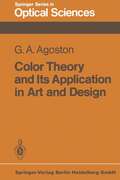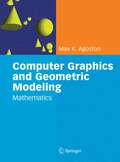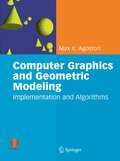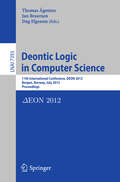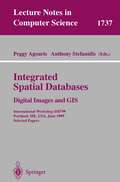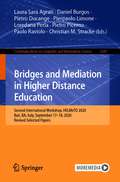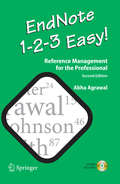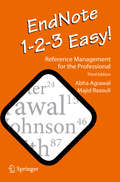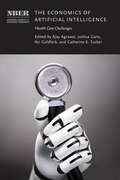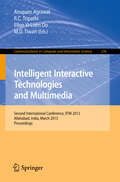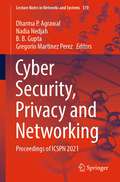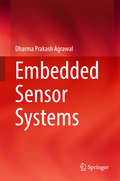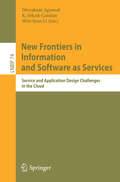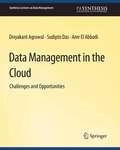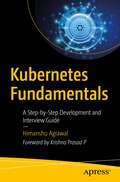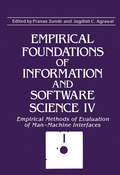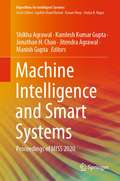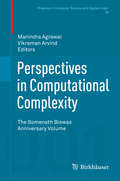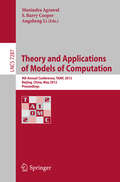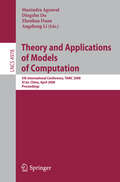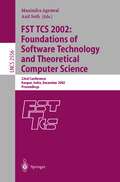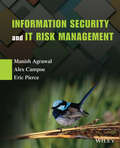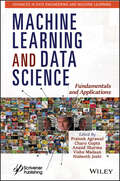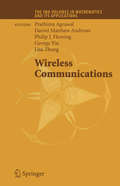- Table View
- List View
Color Theory and Its Application in Art and Design (Springer Series in Optical Sciences #19)
by George A. AgostonMy aim in this introductory text is to present a comprehensible discussion of certain technical topics and recent developments in color science that I believe are of real interest to artists and designers. I treat a number of applications of this knowledge, for example in selection and use of colorants (pigments and dyes) and light. Early in the book I discuss what color is and what its characteristics are. This is followed by a chapter on pertinent aspects of light, light as the stimulus that causes the perception of color. Then the subject of the colors of opaque and transparent, nonfluorescent and fluorescent materials is taken up. There are sections on color matching, color mixture, and color primaries. Chapter 6 introduces the basic ideas that underlie the universal method (CIE) of color specification. Later chapters show how these ideas have been extended to serve other purposes such as systematic color naming, de termining complementary colors, mixing colored lights, and demonstrating the limitations of color gamuts of colorants. The Munsell and the Ostwald color systems and the Natural Colour System (Sweden) are explained, and the new Uniform Color Scales (Optical Society of America) are described. Color specification itself is a broad topic. The information presented here is relevant in art and design, for those who work with pigments and dyes or with products that contain them, such as paints, printing inks, plastics, glasses, mosaic tesserae, etc.
Computer Graphics and Geometric Modelling: Mathematics
by Max K. AgostonPossibly the most comprehensive overview of computer graphics as seen in the context of geometric modelling, this two volume work covers implementation and theory in a thorough and systematic fashion. Computer Graphics and Geometric Modelling: Mathematics, contains the mathematical background needed for the geometric modeling topics in computer graphics covered in the first volume. This volume begins with material from linear algebra and a discussion of the transformations in affine & projective geometry, followed by topics from advanced calculus & chapters on general topology, combinatorial topology, algebraic topology, differential topology, differential geometry, and finally algebraic geometry. Two important goals throughout were to explain the material thoroughly, and to make it self-contained. This volume by itself would make a good mathematics reference book, in particular for practitioners in the field of geometric modelling. Due to its broad coverage and emphasis on explanation it could be used as a text for introductory mathematics courses on some of the covered topics, such as topology (general, combinatorial, algebraic, and differential) and geometry (differential & algebraic).
Computer Graphics and Geometric Modelling: Implementation & Algorithms
by Max K. AgostonPossibly the most comprehensive overview of computer graphics as seen in the context of geometric modelling, this two volume work covers implementation and theory in a thorough and systematic fashion. Computer Graphics and Geometric Modelling: Implementation and Algorithms, covers the computer graphics part of the field of geometric modelling and includes all the standard computer graphics topics. The first part deals with basic concepts and algorithms and the main steps involved in displaying photorealistic images on a computer. The second part covers curves and surfaces and a number of more advanced geometric modelling topics including intersection algorithms, distance algorithms, polygonizing curves and surfaces, trimmed surfaces, implicit curves and surfaces, offset curves and surfaces, curvature, geodesics, blending etc. The third part touches on some aspects of computational geometry and a few special topics such as interval analysis and finite element methods. The volume includes two companion programs.
Deontic Logic in Computer Science: 11th International Conference, DEON 2012, Bergen, Norway, July 16-18, 2012, Proceedings (Lecture Notes in Computer Science #7393)
by Thomas Agotnes Jan M. Broersen Dag ElgesemThis volume presents the refereed proceedings of the 11th International Conference on Deontic Logic in Computer Science, DEON 2012, held in Bergen, Norway, in July 2012. The 14 revised papers included in the volume were carefully reviewed and selected from 29 submissions. Topics covered include logical study of normative reasoning, formal analysis of normative concepts and normative systems, formal specification of aspects of norm-governed multi-agent systems and autonomous agents, normative aspects of protocols for communication, negotiation and multi-agent decision making, formal representation of legal knowledge, formal specification of normative systems for the management of bureaucratic processes in public or private administration, and applications of normative logic to the specification of database integrity constraints.
Integrated Spatial Databases: International Workshop ISD'99 Portland, ME, USA, June 14-16, 1999 Selected Papers (Lecture Notes in Computer Science #1737)
by Peggy Agouris Anthony StefanidisBridges and Mediation in Higher Distance Education: Second International Workshop, HELMeTO 2020, Bari, BA, Italy, September 17–18, 2020, Revised Selected Papers (Communications in Computer and Information Science #1344)
by Laura Sara Agrati Daniel Burgos Pietro Ducange Pierpaolo Limone Loredana Perla Pietro Picerno Paolo Raviolo Christian M. StrackeThis book constitutes the thoroughly refereed post-conference proceedings of the Second International Workshop on Higher Education Learning Methodologies and Technologies Online, HELMeTO 2020, held in Bari, Italy, September 2020. Due to the COVID-19 pandemic the conference was held online. The 25 revised full papers and 3 short papers presented were carefully reviewed and selected from a total of 59 submissions. The papers present recent research on challenges of implementing emerging technology solution for online, online learning pedagogical frameworks, facing COVID19 emergency in higher education teaching and learning, online learning technologies in practice, online learning strategies and resources, etc.
EndNote 1 - 2 - 3 Easy!: Reference Management for the Professional
by Abha AgrawalEndnote Made Easy: Reference Management for the Professional is intended for healthcare professionals (physicians, nurses, managers, etc.) and biomedical researchers engaged in writing scientific manuscripts. It aids readers in gaining an understanding of the effective use of information technology in storing, managing, retrieving, and citing references in scientific writings. It also provides step by step instruction on using Endnote, a popular reference management software.
EndNote 1-2-3 Easy!: Reference Management for the Professional
by Abha Agrawal Majid RasouliThis book is intended for healthcare professionals, biomedical researchers, health policy experts, and graduate students who frequently write and publish scientific manuscripts in peer reviewed journals. This new edition updates earlier versions with an emphasis on the most currently available Clarivate Analytics software application EndNote X9, a widely used reference management software. For first-time users of EndNote X9, this book is a comprehensive and well-illustrated instruction manual for getting started, including detailed instructions on installation, creating reference libraries, and ultimately creating complete and accurate citation-based bibliographies necessary to achieve successful peer reviewed publications. There is also a full chapter devoted to careful guidance for the growing practice of citing references from online internet sources. For existing “power users” of current and earlier versions of EndNote, this book provides quick and easy access to a comprehensive compendium of nuanced and advanced features of this powerful software, with an emphasis on providing greater ease and control in coordinating and curating research materials and bibliographies with research collaborators and scientific writing teams. The authors have also added new, state-of-the-art “how-to” guidance on a variety of methods of using EndNote, including PubMed, Google Scholar, Web of Science, Scopus and others. Like many legacy software systems, Clarivate Analytics has also begun to offer an online “desktop” version of EndNote, a topic which is now also covered in Chapter 10 (EndNote Online) of this new edition.
The Economics of Artificial Intelligence: Health Care Challenges (National Bureau of Economic Research Conference Report)
by Ajay Agrawal Joshua Gans Avi Goldfarb Catherine TuckerA timely investigation of the potential economic effects, both realized and unrealized, of artificial intelligence within the United States healthcare system. In sweeping conversations about the impact of artificial intelligence on many sectors of the economy, healthcare has received relatively little attention. Yet it seems unlikely that an industry that represents nearly one-fifth of the economy could escape the efficiency and cost-driven disruptions of AI. The Economics of Artificial Intelligence: Health Care Challenges brings together contributions from health economists, physicians, philosophers, and scholars in law, public health, and machine learning to identify the primary barriers to entry of AI in the healthcare sector. Across original papers and in wide-ranging responses, the contributors analyze barriers of four types: incentives, management, data availability, and regulation. They also suggest that AI has the potential to improve outcomes and lower costs. Understanding both the benefits of and barriers to AI adoption is essential for designing policies that will affect the evolution of the healthcare system.
Intelligent Interactive Technologies and Multimedia: Second International Conference, IITM 2013, Allahabad, India, March 9-11, 2013. Proceedings (Communications in Computer and Information Science #276)
by Anupam Agrawal R. C. Tripathi Ellen Yi-Luen Do M. D. TiwariThis book constitutes the refereed proceedings of the Second International Conference on Intelligent Interactive Technologies and Multimedia, IITM 2013, held in Allahabad, India, in March 2013. The 15 revised full papers and the 12 revised short papers were carefully reviewed and selected from more than 90 submissions. The papers present the latest research and development in the areas of intelligent interactive technologies, human-computer interaction and multimedia.
Cyber Security, Privacy and Networking: Proceedings of ICSPN 2021 (Lecture Notes in Networks and Systems #370)
by Dharma P. Agrawal Nadia Nedjah B. B. Gupta Gregorio Martinez PerezThis book covers selected high-quality research papers presented in the International Conference on Cyber Security, Privacy and Networking (ICSPN 2021), organized during 17-19 September 2021 in India in Online mode. The objectives of ICSPN 2021 is to provide a premier international platform for deliberations on strategies, recent trends, innovative approaches, discussions and presentations on the most recent cyber security, privacy and networking challenges and developments from the perspective of providing security awareness and its best practices for the real world. Moreover, the motivation to organize this conference is to promote research by sharing innovative ideas among all levels of the scientific community, and to provide opportunities to develop creative solutions to various security, privacy and networking problems.
Embedded Sensor Systems
by Dharma Prakash AgrawalThis inspiring textbook provides an essential introduction to wireless technologies for sensors, explores the potential use of sensors for numerous applications, and utilizes probability theory and mathematical methods as a means of embedding sensors in system design. The book discusses the need for synchronization and underlying limitations, the interrelation between given coverage and connectivity to the number of sensors needed, and the use of geometrical distance to determine the location of the base station for data collection, while also exploring the use of anchor nodes to determine the relative positions of sensors. The book addresses energy conservation, communication using TCP, the need for clustering and data aggregation, and residual energy determination and energy harvesting, together with key topics in sensor communication like mobile base stations and relay nodes, delay-tolerant sensor networks, and remote sensing and potential applications. The book defines routing methods and performance evaluation for random and regular sensor topology and covers sensor-based intrusion detection. The book focuses on applications such as interaction with actuators, final design with respect to a given application, personal and body-area networks for health-care applications and sensor networks as an integral component of the IoT. The importance of both coverage and connectivity is examined thoroughly in both randomly deployed sensor networks for defense applications and regularly placed sensors for an industrial setup. The content includes exercises as well as design-based project concepts. The book’s comprehensive coverage makes it well suited for use as a textbook for graduate and upper undergraduate courses, or as course material for professional courses.
New Frontiers in Information and Software as Services: Service and Application Design Challenges in the Cloud (Lecture Notes in Business Information Processing #74)
by Divyakant Agrawal K. Selçuk Candan Wen-Syan LiThe increasing costs of creating and maintaining infrastructures for delivering services to consumers have led to the emergence of cloud based third party service providers renting networks, computation power, storage, and even entire software application suites. On the other hand, service customers demand competitive pricing, service level agreements, and increased flexibility and scalability. Service consumers also expect process and data security, 24/7 service availability, and compliance with privacy regulations. This book focuses on such challenges associated with the design, implementation, deployment, and management of data and software as a service. The 12 papers presented in this volume were contributed by leaders in academia and industry, and were reviewed and supervised by an expert editorial board. They describe cutting-edge approaches in areas like service design, service security, service optimization, and service migration.
Data Management in the Cloud (Synthesis Lectures on Data Management)
by Divyakant Agrawal Sudipto Das Amr El AbbadiCloud computing has emerged as a successful paradigm of service-oriented computing and has revolutionized the way computing infrastructure is used. This success has seen a proliferation in the number of applications that are being deployed in various cloud platforms. There has also been an increase in the scale of the data generated as well as consumed by such applications. Scalable database management systems form a critical part of the cloud infrastructure. The attempt to address the challenges posed by the management of big data has led to a plethora of systems. This book aims to clarify some of the important concepts in the design space of scalable data management in cloud computing infrastructures. Some of the questions that this book aims to answer are: the appropriate systems for a specific set of application requirements, the research challenges in data management for the cloud, and what is novel in the cloud for database researchers? We also aim to address one basic question: whether cloud computing poses new challenges in scalable data management or it is just a reincarnation of old problems? We provide a comprehensive background study of state-of-the-art systems for scalable data management and analysis. We also identify important aspects in the design of different systems and the applicability and scope of these systems. A thorough understanding of current solutions and a precise characterization of the design space are essential for clearing the "cloudy skies of data management" and ensuring the success of DBMSs in the cloud, thus emulating the success enjoyed by relational databases in traditional enterprise settings. Table of Contents: Introduction / Distributed Data Management / Cloud Data Management: Early Trends / Transactions on Co-located Data / Transactions on Distributed Data / Multi-tenant Database Systems / Concluding Remarks
Kubernetes Fundamentals: A Step-by-Step Development and Interview Guide
by Himanshu AgrawalExplore the world of Kubernetes and learn the concepts needed to develop, deploy, and manage applications on this container orchestrator. This step-by-step development guide is designed for application developers and support members aiming to learn Kubernetes and/or prepare for interviews. All the concepts in the book are presented in Q&A format, with questions framed exactly the way they are asked in an interview, giving you a distinctive edge in interviews.You’ll start by understanding how application development and deployment have evolved over the decades leading up to containerization. You’ll then dive deep into core Kubernetes concepts, learning Kubernetes architecture, Kubernetes objects and workload resources, and how to exploit them to their full potential. You’ll also learn Kubernetes deployment strategies and concepts related to rollout and rollback.Moving on, you’ll look at two very important aspects of any computing ecosystem: networking and storage. You will gain an understanding of access control in Kubernetes and how to manage a Kubernetes cluster using probes, resource quotas, taints, and tolerations. You will also get an overview of Docker and review Docker and Kubernetes best practices. Finally, you will learn about the kubectl command line tool.What You Will LearnLearn about basic and advanced Kubernetes objects and workload resourcesMaster important concepts such as namespaces, selectors, annotations, and access controlUnderstand the Kubernetes networking and storage systemManage a Kubernetes cluster with the help of probes, resource quotas, limits, and taintsWho This Book Is For Application developers and technical managers—both on the development and support sides, beginner and intermediate Kubernetes practitioners and aspirants, and those preparing for Kubernetes interviews.
Empirical Foundations of Information and Software Science IV: (pdf)
by Jagdish C. Agrawal Pranas ZundeMachine Intelligence and Smart Systems: Proceedings of MISS 2020 (Algorithms for Intelligent Systems)
by Jitendra Agrawal Jonathan H. Chan Manish Gupta Shikha Agrawal Kamlesh Kumar GuptaThis book is a collection of peer-reviewed best selected research papers presented at the First International Conference on Machine Intelligence and Smart Systems 2020 (MISS 2020), organized during September 24–25, 2020, in Gwalior, India. The book presents new advances and research results in the fields of machine intelligence, artificial intelligence and smart systems. It includes main paradigms of machine intelligence algorithms, namely (1) neural networks, (2) evolutionary computation, (3) swarm intelligence, (4) fuzzy systems and (5) immunological computation.
Perspectives in Computational Complexity: The Somenath Biswas Anniversary Volume (Progress in Computer Science and Applied Logic #26)
by Manindra Agrawal Vikraman ArvindThis book brings together contributions by leading researchers in computational complexity theory written in honor of Somenath Biswas on the occasion of his sixtieth birthday. They discuss current trends and exciting developments in this flourishing area of research and offer fresh perspectives on various aspects of complexity theory. The topics covered include arithmetic circuit complexity, lower bounds and polynomial identity testing, the isomorphism conjecture, space-bounded computation, graph isomorphism, resolution and proof complexity, entropy and randomness. Several chapters have a tutorial flavor. The aim is to make recent research in these topics accessible to graduate students and senior undergraduates in computer science and mathematics. It can also be useful as a resource for teaching advanced level courses in computational complexity.
Theory and Applications of Models of Computation: 9th Annual Conference, TAMC 2012, Beijing, China, May 16-21, 2012. Proceedings (Lecture Notes in Computer Science #7287)
by Manindra Agrawal Barry S. Cooper Angsheng LiThis book constitutes the refereed proceedings of the 9th International Conference on Theory and Applications of Models of Computation, TAMC 2012, held in Beijing, China, in May 2012. The conference was combined with the Turing Lectures 2012, dedicated to celebrating Alan Turing’s unique impact on mathematics, computing, computer science, informatics, morphogenesis, philosophy, and the wider scientific world. Eight Turing Lectures were given at the TAMC 2012. The 40 revised full papers presented together with invited talks were carefully reviewed and selected from 86 submissions. The papers address 4 special sessions at TAMC 2012 which were algorithms and information in networks, complexity and cryptography, models of computing and networking, programming and verification.
Theory and Applications of Models of Computation: 5th International Conference, TAMC 2008, Xi'an, China, April 25-29, 2008, Proceedings (Lecture Notes in Computer Science #4978)
by Manindra Agrawal Ding-Zhu Du Zhenhua Duan Angsheng LiFST TCS 2002: 22nd Conference Kanpur, India, December 12-14, 2002, Proceedings (Lecture Notes in Computer Science #2556)
by Manindra Agrawal Anil SethThis volume consists of the proceedings of the 22nd International Conference on the Foundations of Software Technology and Theoretical Computer Science (FSTTCS 2002), organized under the auspices of the Indian Association for Research in Computing Science (IARCS). The conference was held at the Indian Institute of Technology, Kanpur during December 12–14, 2002. The conference attracted 108 submissions (of which two were withdrawn). Of these, a total of 26 papers were selected for presentation in the conference. As in the last year, the PC meeting was held electronically (stretching over nearly three weeks in August 2002) and was a great success. In addition to the contributed papers, we had ?ve invited speakers this year: Hendrik Lenstra, Jr., Harry Mairson, Dale Miller, Chih-Hao Luke Ong, and Margus Veanes. We thank them for accepting our invitation and for providing abstracts (or even full papers) for the proceedings. Two workshops were organized in conjunction with the conference – both in Kanpur. A workshop on Parameterized Complexity was held during December 10–11, organized by Mike Fellows and Venkatesh Raman. The second workshop actually consisted of three miniworkshops: on Coding Theory by Madhu Sudan; on Finite Field Algorithms by Hendrik Lenstra, Jr.; and on Sieve Theory by R. Balasubramanian. We wish to thank all the reviewers and PC members who contributed greatly to making the conference a success. We also wish to thank the team at Springer- Verlag for their help in preparing the proceedings.
Information Security and IT Risk Management
by Manish Agrawal Alex Campoe Eric PierceThis new text provides students the knowledge and skills they will need to compete for and succeed in the information security roles they will encounter straight out of college. This is accomplished by providing a hands-on immersion in essential system administration, service and application installation and configuration, security tool use, TIG implementation and reporting. It is designed for an introductory course on IS Security offered usually as an elective in IS departments in 2 and 4 year schools. It is not designed for security certification courses.
Machine Learning and Data Science: Fundamentals and Applications
by Prateek Agrawal Charu Gupta Anand SharmaMACHINE LEARNING AND DATA SCIENCE Written and edited by a team of experts in the field, this collection of papers reflects the most up-to-date and comprehensive current state of machine learning and data science for industry, government, and academia. Machine learning (ML) and data science (DS) are very active topics with an extensive scope, both in terms of theory and applications. They have been established as an important emergent scientific field and paradigm driving research evolution in such disciplines as statistics, computing science and intelligence science, and practical transformation in such domains as science, engineering, the public sector, business, social science, and lifestyle. Simultaneously, their applications provide important challenges that can often be addressed only with innovative machine learning and data science algorithms. These algorithms encompass the larger areas of artificial intelligence, data analytics, machine learning, pattern recognition, natural language understanding, and big data manipulation. They also tackle related new scientific challenges, ranging from data capture, creation, storage, retrieval, sharing, analysis, optimization, and visualization, to integrative analysis across heterogeneous and interdependent complex resources for better decision-making, collaboration, and, ultimately, value creation.
Machine Learning and Data Science: Fundamentals and Applications
by Prateek Agrawal Charu Gupta Anand Sharma Vishu Madaan Nisheeth JoshiMACHINE LEARNING AND DATA SCIENCE Written and edited by a team of experts in the field, this collection of papers reflects the most up-to-date and comprehensive current state of machine learning and data science for industry, government, and academia. Machine learning (ML) and data science (DS) are very active topics with an extensive scope, both in terms of theory and applications. They have been established as an important emergent scientific field and paradigm driving research evolution in such disciplines as statistics, computing science and intelligence science, and practical transformation in such domains as science, engineering, the public sector, business, social science, and lifestyle. Simultaneously, their applications provide important challenges that can often be addressed only with innovative machine learning and data science algorithms. These algorithms encompass the larger areas of artificial intelligence, data analytics, machine learning, pattern recognition, natural language understanding, and big data manipulation. They also tackle related new scientific challenges, ranging from data capture, creation, storage, retrieval, sharing, analysis, optimization, and visualization, to integrative analysis across heterogeneous and interdependent complex resources for better decision-making, collaboration, and, ultimately, value creation.
Wireless Communications (The IMA Volumes in Mathematics and its Applications #143)
by Prathima Agrawal Matthew D. Andrews Philip J. Fleming G. George Yin Lisa ZhangThis volume contains papers based on invited talks given at the 2005 IMA Summer Workshop on Wireless Communications, held at the Institute for Mathematics and Its Applications, University of Minnesota, June 22 - July 1, 2005. It presents some of the highlights of the workshop, and collects papers covering a broad spectrum of important and pressing issues in wireless communications.
